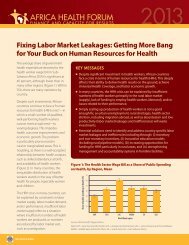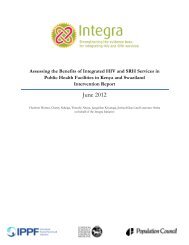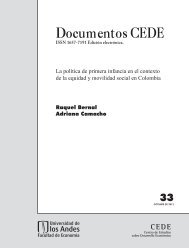ujh78
ujh78
ujh78
You also want an ePaper? Increase the reach of your titles
YUMPU automatically turns print PDFs into web optimized ePapers that Google loves.
4 Water and Sanitation Deprivation<br />
This chapter presents stratified percentages of children considered severely deprived of water<br />
because they lived in households that used surface water or had more than a 15-minute walk to their water<br />
source. The rationales for these two measures is that surface water can become polluted and thus<br />
dangerous, and a 15-minute walk to a water source (30 minutes round trip) means that the child likely will<br />
have access to only a severely limited quantity of water at home (Gordon et al., 2003).<br />
Information regarding sanitation deprivation focuses on the percentage of children who do not<br />
have access to any sanitation facilities in or near their homes, including any connection to a public sewer<br />
or connection to a septic system or access to a pour-flush latrine, simple pit latrine, ventilated improved<br />
pit latrine, service or bucket latrines where excreta are removed manually, public latrines, or open<br />
latrines. We conducted the analyses using data for children up to age 17.<br />
4.1 Use of Surface Water<br />
To reduce diarrheal disease and, consequently, child mortality, the Millennium Development<br />
Goals call for reducing by half the proportion of people without sustainable access to safe drinking water<br />
(Peterson Zwane and Kremer, 2007). One-sixth of the world's population (884 million people) have no<br />
access to improved sources of drinking water such as piped household water connections, public<br />
standpipes, boreholes, protected dug wells, protected springs, or rainwater collection (Mara, 2003; WHO<br />
and UNICEF, 2010). People without access to improved sources of drinking water generally use surface<br />
water instead, including water from dams, rivers, and streams. Unfortunately, surface water is frequently<br />
contaminated with pathogens, including bacteria, viruses, and parasites, due to contact with human and<br />
livestock waste (Effler et al., 2001; Fong and Lipp, 2005; Kistemann et al., 2002; Peterson Zwane and<br />
Kremer, 2007). For this reason, surface water often transmits waterborne and water-related diseases when<br />
used for domestic purposes.<br />
The use of surface water for human consumption is a global health concern because there are<br />
approximately 3.5 billion episodes of diarrhea per year and 1.87 million childhood deaths per year<br />
worldwide linked to waterborne and water-related diseases (Arnold and Colford, 2007; Boschi-Pinto et<br />
al., 2008; Effler et al., 2001; Fong and Lipp, 2005; Kistemann et al., 2002; Peterson Zwane and Kremer,<br />
2007). According to the United Nations World Water Development Report 3: Water in a Changing<br />
World, more than half of malnutrition cases in Africa result from recurring diarrhea or intestinal nematode<br />
infections resulting from consuming contaminated water. In the developing world several recent<br />
epidemics related to the lack safe drinking water have resulted from toxigenic Vibrio cholerae,<br />
Salmonella, Shigella, Escherichia coli pathotypes, Cryptosporidium, and Giardia (Bielaszewska et al.,<br />
2011; Centers for Disease Control and Prevention, 2012; Chigor et al., 2012; Mills-Robertson et al., 2003;<br />
Stewart-Tull, 2001; Zahid et al., 2008).<br />
Our analyses found vast differences among sub-Saharan countries in the percentage of children<br />
less than age 18 who used surface water (see Map 4.1). For instance, less than 2% of children used<br />
surface water in Senegal and Niger. In contrast, more than 60% of children in Burundi and 50% in<br />
Rwanda used surface water (see Table 4.1).<br />
Sex and geographic disparities<br />
Overall, we did not find child’s sex disparities related to the use of surface water in sub-Saharan<br />
Africa (see Figure 4.1). We did find geographic disparities, however (see Figure 4.2). In all these<br />
countries a higher percentage of children used surface water in rural areas than in urban areas. Geographic<br />
disparities were greatest in Burundi (urban: 15% and rural: 72%) and Ethiopia (urban: 8% and rural:<br />
59








